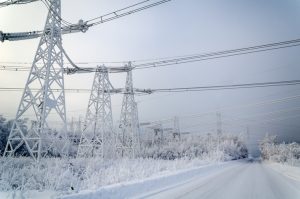
How Did Cold Weather Freeze The Texas Grid?
With Arctic-like cold and wind chills likely sticking around Texas until the weekend, many electricity customers inn ERCOT are finding time to wonder what happened on Sunday, February 15. After all, the past week’s cold weather catastrophe seems more at home in the bleak whiteness of Jack London’s Yukon than sunny Sugar Land. To help sort it all out, we’ve been assembling the story as the facts emerge. And as with any raw crisis, we’ve discovered a whole lot of questions to answer. Just how did a winter cold snap freeze up the ERCOT grid anyway? How could it affect your electric bill? And — more importantly — could it happen again?
How the Arctic Vortex and Winter Storm Froze Texas
Each winter, cold air over the North Pole forms a vortex that spins cold air around the northern region. Last year, a normal low pressure kept the Arctic Vortex bound up nice and tight over the North Pole. But this winter, high pressure over the Pole sloshed the Arctic Vortex across the northern hemisphere. In early January, the Arctic vortex underwent a “Sudden Stratospheric Warming” event that broke up the vortex and sent smaller daughter vortices whirling across the northern hemisphere.
As Ground Hog day dawned, One of those vortices flowed into an atmospheric trough over the middle of the U.S. This trough led far south deep into the heart of Texas. Bitter cold temperatures flowed southward. On February 11, ERCOT warned to expect “record electric use as a result of the extreme cold temperatures that have already reached much of the ERCOT region”.
Within two days, a storm system developed in the Pacific northwest. Strengthening as it moved east, it veered to Texas, changing into snow and ice. For the first time on record, the National Weather Service issued Winter Storm Warnings for all 254 counties in the state. As a result, the Railroad Commission of Texas issued an emergency order to protect residential customers by prioritizing deliveries of gas to electric generation facilities.
Texas Generation Mix
According to ERCOT, its Texas generation supply is roughly 22% coal, 35% combined cycle natural gas, 12% nuclear plants, and 25% wind. ERCOT’s annual winter forecast planned for 67,200 MW of coal, natural gas, and nuclear, 24,962 MW of wind, and about 3,800 from solar.
But as Texas temperatures plummeted and customer demand for electricity to heat homes rose and rose. That afternoon, ERCOT formally requested the U.S. Department of Energy to authorize all its generating units to run full blast. The request named 99 coal, natural gas, and fuel oil burning plants. That means that the fuel mix the night of February 14 favored about 67,000 MW from “thermal generators”; natural gas, coal, nuclear, and oil.
Thermal generators use heat to make steam and spin up a turbine that generates electricity. So, it’s a little ironic that thermal plants are susceptible to freezing because many of these plants have exposed steam pipes and switching systems. They perform great under “normal” warm Texas conditions. But when temperatures get bitterly cold, pipes, valves, compressors, gauges, and switches can freeze up and cause shut downs.
Meanwhile, natural gas contains a built-in problem: water vapor. Natural gas, even consumer-grade “dry gas”, can freeze up in pipelines and compressor stations when pressure drops due to power loss or too much gas is taken out of the pipeline. That’s when ice forms in the pipeline and blocks the flow. For Texas natural gas fueled generating stations, these freeze offs shut them down hard.

What Started The Electric Outages?
During the night of Sunday, February 14, winter peak-demand in ERCOT hit a record of 69,150 MW. Beginning around 11 pm multiple generation stations rapidly tripped offline due to the effects of brutal cold weather. Outages from coal and natural gas plants were at least 10,000 MW over what ERCOT planned for it worst-case scenario.
Between 12:17 AM and 1:25 AM on Monday, February 16, the system began failing, dropping went from “conservation needed” to “rotating outages“. At that point ERCOT asked TDUs to shed 16,500 MW of load or about 2 million homes worth of electricity. By mid-morning, ERCOT had lost about 34,000 MW of capacity; roughly 40% of its operable capacity. Most of that loss came from thermal plants while less than 13% was lost due to wind turbine blades icing up.
Why Rolling Black Outs?
Part of ERCOT’s job is not only to match demand to generators’ supply but also to make sure the grid is safe. However, if demand exceeds supply, ERCOT has several tricks it can use. First it may lower the grid’s frequency from 60 Herz to 58 Herz. It might also lower the voltage slightly below 110 volts (causing brownouts). However, if supply falters further and frequency falls below 56 Herz or the voltage drops too much, then resonate frequencies or heat flux density problems in their cores can burn or melt generators. Even too much line noise will damage control and switching equipment needed to bring on additional generators. In short, too much load can burn out the whole grid.
The easiest way to keep the ERCOT grid stable is for the TDUs to reduce load. The fairest way to do it is through rolling blackouts. That way, everyone loses power but only for a little while. ERCOT’s Energy Emergency Rules specify that black outs are limited from 10 to 45 minutes and that TDUs (like CenterPoint and Oncor) are responsible for determining how they shed load in their service areas.
Or that’s at least what ERCOT intended when it ordered rolling black outs on February 15.
Why Did ERCOT Just Black Out?
On Monday, February 16, nighttime weather conditions deteriorated further. ERCOT scrambled to find working generators and balance their system. By 4 PM, ERCOT had managed to restore approximately 2,500 MW of load. But with temperatures falling into teens that night, ERCOT requested another 18,500 MW of load to be shed. By Tuesday, about 45,000 MW and over 180 generators had gone offline.
ERCOT and the TDUs scrambled for generation as it became available. But at the same time supply had to balance load to keep the grid stable. On Tuesday afternoon, CenterPoint warned Houston residentsto prepare for power outages as generators continued to struggle. Even the South Texas Nuclear Power Station shut down about 1450 MW when cold weather affected its feedwater system.
The Big Texas Freeze Problem Spreads North
Shortages from natural gas freeze offs didn’t end at the the “Welcome to Texas” sign. Texas is top producer of natural gas in the U.S. Its wells supply gas used for heating in northern states via major pipeline networks. Nearly half of the state’s natural gas production has screeched to a halt as wells in the Permian Basin, Eagle Ford, and other gas fields froze off.
Monday gas supplies to northern states faltered. Some 17 States, some seeing temperatures below -25°F and as far north as Iowa, Nebraska, Minnesota, and the Dakotas were hit with energy shortages that included low natural gas supply for heating and rolling black outs. Consequently, this big Texas Freeze isn’t just a Texas problem. It’s a national one.
When Will My Lights Come On?
As of Friday, February 19, ERCOT had cancelled the emergency and is reporting “normal” conditions. Prices have slid to their normal levels. But even though Texas generators are supplying over 46,000 MW of demand, thousands of homes were still without power and millions of people are having problems with water services.
Texas TDU Outage Trackers
Outages as of Friday, February 19
CenterPoint reports 6,726 Customers without power.
Oncor reports 4,493 outages, 92,477 customers affected.
AEP Texas reports 15,900 Customers without power.
TNMP reports 10 customers without power.
Meanwhile, a warm up moving in on Saturday, February 20. The National Weather service is forecasting the good news that “near to above normal temperatures for southeast Texas through the end of February and into early March. ”
What Happens To My Retail Electricity Provider (REP)?
The huge problem facing Texas Retail Electricity Providers was that prices soared to the stratosphere on Monday, February 16, hitting the ERCOT market cap of $9,000 per MWh (that’s $9 per kWh). Much of that was due to the PUCT ordering ERCOT that energy prices should reflect scarcity of the supply. Companies offering customers wholesale rates, like Griddy, told customers that they should switch to another provideras soon as possible or face insanely high bills. Other providers offered customers $100 rebates and waived cancellation fees as incentives to switch to another provider.
The PUCT kept that rule in place until ERCOT finally cancelled the rolling black out emergency on Friday, February 19 at 9 AM. But during that time, ERCOT demanded that retailers needed to cough up cash for collateral for the Day Ahead Markets. Though big Texas energy companies like NRG and Vistra dig into their deep pockets to pay billions this week, small companies are scrambling to pay millions in collateral charges – in one case up to $6.5MM for less than 4,000 residential customers.
As a result, REPs could be bushwhacked by financial troubles as their bills come due. That means customers should keep a weather-eye peeled for some companies raising electricity rates or changing ownership. One retailer has already formally asked the PUCT to re-price rates during the emergency period to a cap of no more $1,500 per megawatt hour for energy. It is not know as of this writing how the PUCT will react.
Will This Happen Again?
Arctic vortex visits are not new to North America. Take for example the winter of 2013 to 2014 which brought record cold to normally sultry Georgia and Florida. To find the last time Texas hit this kind of record cold, you have to dig into the weather stats going back to the 1899. But history shows you don’t need record cold to bring the Texas grid to its knees. You just need poor preparation.
The 2011 Ground Hog Day Freeze-Off started with record cold temperatures and high winds shutting down 50 power plants. Seven of these were coal-fired plants (four were then brand new) that failed from winds and icing. A total of 8,000 MW shut down. Wind turbines, however, limped on and kept producing. In response, ERCOT instituted blackouts and the wholesale price of electric jumped from $70 per MW to $3,001 per MW. Fortunately for electricity customers in Houston, high rates were short lived.
As then ERCOT Chief Tripp Doggett explained to the Dallas News covering the event, “Things that you would expect to winterize prior to a cold period are the problems. In a lot of cases, I suspect, they were wrapped in insulation, and perhaps they underestimated the amount of insulation needed. Perhaps they didn’t recognize they needed a heat source near the insulation.”
The investigating taskforce later validated Daggett when they reported that there were no state or industry regulatory rules mandating power plant winterization. Unfortunately for Texas energy customers , that policy is ongoing. ERCOT does request power plants to perform checks and follow “best practices”. However, generator winterization mandates still do not exist in Texas law.
Governor Greg Abbott is now urging lawmakers to pass legislation requiring the energy grid is cold weather-ready.
